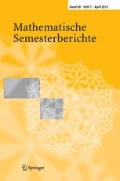Zusammenfassung.
Die mathematische Struktur des gregorianischen Kalenders wird anhand der Kalendergleichungen erläutert. Diese werden aus bekannten Zyklen des gregorianischen Kalenders hergeleitet. Die Säkularschaltregel „In je vier Säkularjahren entfallen je drei Schalttage“ wird nachvollziehbar entwickelt. Eine neue und bessere Säkularschaltfunktion für den „Kalendermond“ wird vorgestellt. Die revidierte Form der Gaußschen Osterformel wird etwas verkürzt.
Abstract.
The mathematical structure of the Gregorian calendar is discussed on the basis of the Calendar equations which are derived from known cycles of the Gregorian calendar. The origin of the rule “in every four centuries every three centennial leap years revert to common years” can now be explained in an understandable manner. A new and better Secular Leap function is obtained for the “calendar moon”. The revised version of Gauss’s Easter formula is given in a slightly shortened form.
Author information
Authors and Affiliations
Corresponding author
Rights and permissions
About this article
Cite this article
Lichtenberg, H. Das anpassbar zyklische, solilunare Zeitzählungssystem des gregorianischen Kalenders. Math. Semesterber. 50, 45–76 (2003). https://doi.org/10.1007/s00591-003-0063-0
Issue Date:
DOI: https://doi.org/10.1007/s00591-003-0063-0

